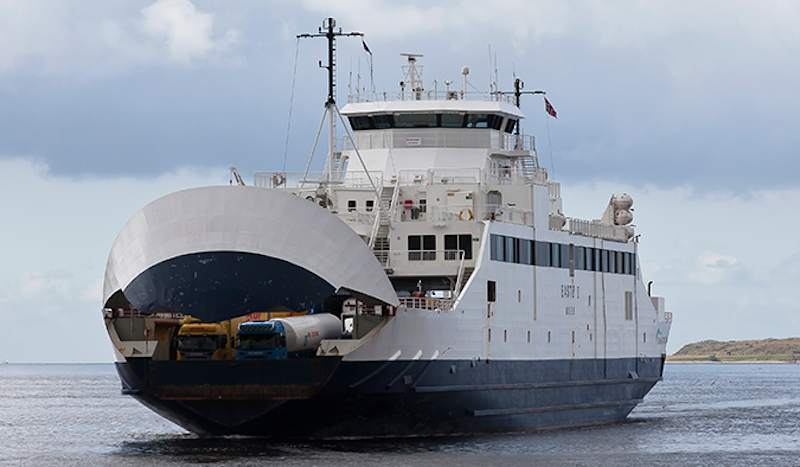The Environmental Protection Agency’s phased-in approach to rein in marine diesel emissions has reached Tier 4. The new standards went into effect Jan. 1, 2017, for most of the industry.
Tier 4 targets three pollutants: nitrogen oxide (NOx), sulphur dioxide (SOx) and particulate matter (PM). Engine manufacturers have largely turned to systems used by over-the-road trucks to achieve the reductions. The selective catalytic reduction (SCR) system uses an “aftertreatment” that sprays a urea-based solution on the exhaust that acts to neutralize the NOx and as a scrubber to capture PM.
GE Transportation (now part of Wabtec Corp.) took another tack, or more aptly, another track — it marinized the compliance solution developed for its locomotive engines. Seventy-percent of railroad locomotives on the rails today in the U.S. use GE Transportation diesel engines. When faced with the Tier 4 compliance deadline, the rail industry asked engine manufacturers to find a solution that would not require the added infrastructure of storing and transporting the urea solution. GE spent approximately $700 million on research, engineering, and testing over the past 10 years and hosted an in-house engineering competition to develop the now fully operating Exhaust Gas Recirculation (EGR) system. The EGR system alters the combustion temperature within the engine greatly reducing the production of NOx and PM.

Patrick Webb
“This system is a paradigm shift. It is really an amazing solution,” said Patrick Webb, sales director-Americas for GE Transportation. “And we are the only ones who have developed an engine for the workboat industry that uses EGR.”
WorkBoat sat down with Webb to get a preview of what he will discuss at this year’s International WorkBoat Show during his Dec. 4 presentation, part of that day’s Tugs and Coastal Towing program.
WorkBoat: So, how do the EPA Tier 4 emissions reduction standards impact the industry?
Patrick Webb: As of January 1, 2017, all marine diesel engine that fit EPA’s Category 2, which is basically any 2,000-6,000-hp engine, must comply with Tier 4. The standards call for, among other things, a 70% reduction in NOx over the Tier 2 standards. That means that anyone looking to build medium to large ships or tugs needs to understand the demands of this new emission standard.
WB: How are manufactures achieving these goals?
Webb: Every major marine engine producer utilized an already proven technology, used by many engine applications around the world, to meet the Tier 4 emission standard. That more common system is called the SCR (selective catalytic reduction) system that doses the exhaust with a urea-based solution called diesel emission fluid (DEF) that causes a chemical reaction that allows the exhaust molecules to meet the emission requirements. This type solution, however, requires the transporting, storing, and managing of DEF in special onboard storage tanks and periodic exhaust box cleaning. This type solution adds consumables cost, logistics, and maintenance to a standard plug-and-play diesel engine.
WB: What is the alternative to the SCR system?
Webb: GE Transportation already had an excellent product — especially with a very successful heavy haul rail power business — in its medium speed, four stroke diesel engines. However, in the marine market, it was in a crowded market and after about 15 years, the GE Transportation diesel engine had some success, but was not widespread. The current Tier 4 marine diesel from GE Transportation, in contrast, has been experiencing unprecedented success. With the roll out of the only certified Tier 4 marine diesel engine that does not require aftertreatment or Urea. This power solution is catching on, big time … the competitive advantages of being the only Tier 4 compliant marine diesel that addresses compliance within the engine itself, not requiring any aftertreatment or fluids or related expense. This Tier 4 engine builds upon the legacy of an amazing legacy diesel engine line that is extremely reliable with worldwide installed base of engines numbering over 22,000.
WB: How does the EGR system meet the standards?
Webb: By precisely recirculating a relatively small percentage of the exhaust through a valve and cooler system, the combustion temperatures are lowered to the exact amount so as to avoid the production of NOx, yet maintaining clean efficient combustion whereby eliminating the particulate matter as well. This balance has been developed and proven over the past many years of research, development, engineering, and testing, which has made for a very reliable and clean diesel engine. It’s so reliable and efficient, that the maintenance schedule and fuel economy are also both industry leading.
WB: OK, but how about the cost?
Webb: Actually, the marketplace for marine diesels is always competitive. We would get nowhere if this engine was not extremely competitively priced. What’s interesting, though, is the fuel, urea, and maintenance savings that this engine offers allows for extraordinary annual operational savings that make this engine highly attractive economically.
WB: Are there other marine applications for the EGR technology?
Webb: We are now introducing our Tier 4 marine diesel lineup to the military and government market sector. Much of the government and defense projects do not comply with emissions standards through the use of a national security exemption. The government chooses to not follow their own EPA emission standards because of the difficult challenges and high cost of the more commonly offered SCR engine technology. Navy ships, for example do not want to carry and manage a urea system, especially with lengthy deployments. However, with the EGR technology, there would no longer be a need for a national security exemption for the Government to have fully compliant diesel engines. Although we have only begun introducing this technology to the government, the response has already been exceptional.




